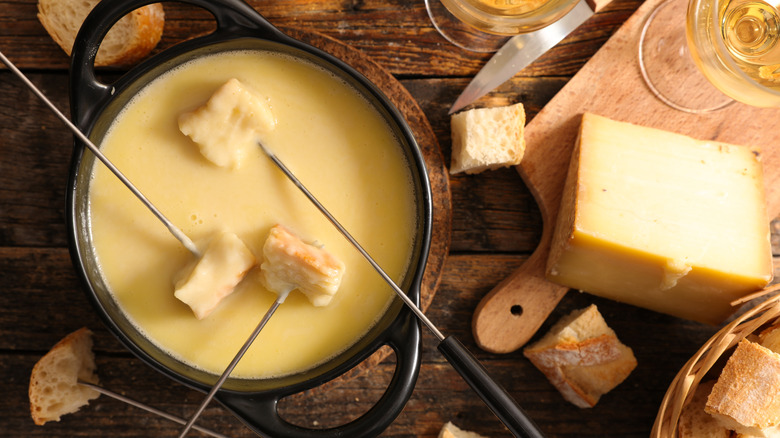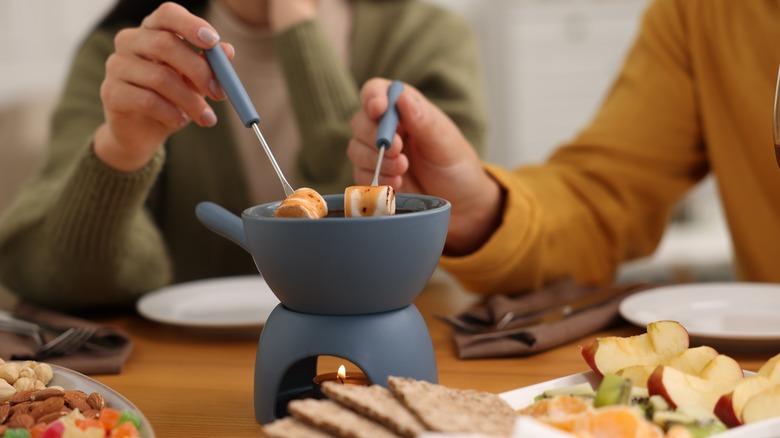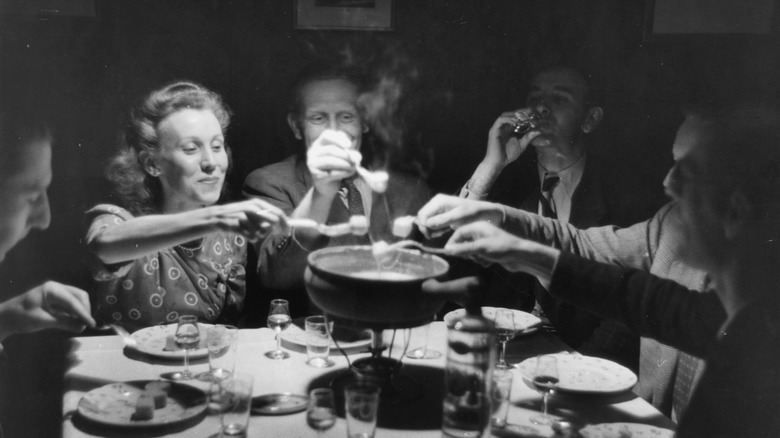No, You Shouldn't Just Use Any Old Fork For Fondue
Making fondue doesn't always have to include a special pot and utensils. Sometimes it involves cooking extra-gooey cheese over a campfire in a heavy-bottomed pot or melting cheese under your oven's broiler. But if you have the right gear, it can be fun to follow traditional fondue etiquette to a tee. Part of that etiquette involves using the correct forks.
For more reasons than one, you can't eat fondue with just any old fork. The flat handles of standard table forks are liable to slip from your grasp into a cauldron of hot chocolate or cheese. Plus, their flat prongs aren't equipped to hang onto bread and other dippers.
Fondue forks' slightly curved two- or three-pronged spears resemble seafood or cocktail forks, but a fondue fork is characterized by its handle, which is wider than its slim stainless steel rod. This wider handle catches the fork on the edge of the fondue pot, so it doesn't slip from your fingers into a hot, melty abyss. The handles, which are often made of wood or resin, also provide a barrier between your hand and the hot steel — because nothing puts a damper on a fondue party like a second-degree burn.
Fondue fork do's and don'ts
While all fondue forks share the basic characteristics outlined above, they come in more than one shape and size. Using the right one depends on which type of fondue you have brewing.
Cheese fondue calls for forks with a long handle and three-pronged tips that are sharp and grippy enough to pierce through bread and other bites. Meanwhile, brothy or oil-based meat fondue calls for two-pronged forks.
Heating a pot of chocolate fondue? You'll have the best luck with a shorter fondue fork, as chocolate fondue pots tend to be smaller than ones for cheese and meat. For a more casual chocolate fondue affair (fondue in the park?), disposable two-pronged bamboo spears are also appropriate.
Another common marker of fondue forks — which are often sold in sets alongside fondue pots — are the colored tips at the ends of the handles, which allow guests to keep track of whose is whose, allowing you and others to avoid accidentally sharing a utensil.
From 'Iliad' to the World's Fair
Speaking of germs, cleanliness is a big part of fondue-fork etiquette. Unless you're rocking a fondue party for one, double-dipping is a fond-don't. Likewise, avoid eating directly off of your fork. Not only will you probably burn your mouth, but you'll also add your germs back into the pot. After you've dipped, transfer your fondue bite to a plate and eat it with a table fork. "You should be treating the fondue fork as a serving item," etiquette expert (and host of the Netflix show "Mind Your Manners") Sara Jane Ho told Eater. "Unless it's chocolate fondue and it's your lover and you don't mind swapping spit."
As for what you choose to dip in your fondue pot, you can make the rules. Bread and hearty vegetables (think broccoli, cauliflower, and brussels sprouts), roasted potatoes, and cured meats are classic options for cheese fondue, but don't be afraid to lean on a sweet-salty combo with apples, pears, and other fruit.
For chocolate fondue, flip the salty-sweet script with dippers like popcorn and soft pretzels to serve alongside sliced bananas, strawberries, marshmallows, cookies, and other sweet treats. Just be sure those dippers are soft enough to be pierced by a fondue fork—resisting the urge to hand-dunk a hard pretzel into a hot pot of chocolate is an absolute must.


